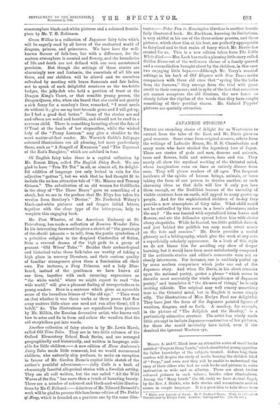JAPANESE STORIES.*
THERE are unending stores of delight for us Westerners to extract from the tales of the East, and Mr. Davis gives us good measure. Some come from original sources, others from the writings of Lafcadio Hearn, Mr. B. H. Chamberlain and many more who have studied the legendary lore of Japan. There are stories of gods and men, demons and animals, trees and flowers, bells and mirrors, fans and tea. They nearly all show the mystical working of the Oriental mind, whose imagination runs on -lines so entirely diverse from ours. They will please readers of all ages. The frequent incidents of the spirits of human beings, animals, or trees taking the form of one 'person to deceive another, or such charming ideas as that dolls will live if only you love them enough, or the Buddhist lessons of the unreality of visible existence here on earth, will appeal to many grown-up people. And for the sophisticated children of to-day they provide a new atmosphere of fairy tales. What child would not be enthralled by this scene in a hero's adventures under the sea P "He was feasted with crystallized lotus leaves and flowers, and ate the delicacies spread before him with choice ebony chopsticks. While he feasted, ten little goldfish danced, and just behind the goldfish ten carp made sweet music on the koto and samisen." Mr. Davis provides a useful glossary and a bibliography, which give the work at any into a superficially scholarly appearance. In a book of this style we do not blame him for avoiding any show of deeper learning, but it would have been more satisfactorily composed if the authentic stories and editor's comments were not so closely interwoven. For instance, one is suddenly pulled up by some modern comparison which jerks one out of the Japanese story. And when Mr•. Davis, in his short remarks upon the national poetry, quotes a phrase " which seems to describe most accurately the whole significance of Japanese poetry," and translates it " the Ah-ness of things," he is only inviting ridicule. The original may well convey something true to the Oriental mind, but in English it seems simply silly. The illustrations of Miss Evelyn Paul are delightful. They have just the form of the Japanese painted figures of warriors, dragons, and so forth. A monkey, for example, in the picture of " The Jellyfish and the Monkey," is a. particularly attractive creature. The artist has wisely made little attempt to imitate Japanese construction of her pictures, for there she would inevitably have failed, even if she deceived the ignorant Western eye.


























































 Previous page
Previous page